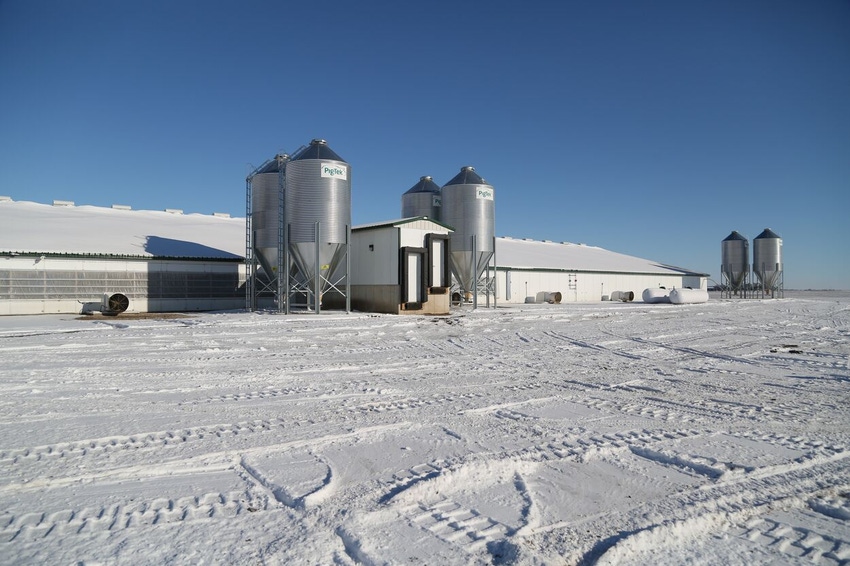At the last sampling, 11 samples tested positive for APP by PCR at the rendering box, feed plates and floor samples collected in front of feeders.
January 16, 2023

In late November 2021, outbreaks of Actinobacillus pleuropneumoniae serotype 15 in the upper Midwest were detected.
The outbreaks were unusual in several respects, including:
the relatively rarity of APP15 isolation in the United States
the unusually high mortality for this strain
the epidemiologic evidence of lateral transmission between systems within a narrow geographic radius
Following the outbreak, the Swine Health Information Center funded work with Derald Holtkamp of Iowa State University to lead a team evaluating possible sources of APP15 transmission between company-owned sites with outbreaks. In parallel, SHIC funded work with Alyona Michael and Marcelo Almeida, ISU Veterinary Diagnostic Lab, to rule out endemic maintenance of APP15 in sow herds that had supplied finishers impacted in 2021 and to characterize post-outbreak ecology for identification of risk factors for lateral transmission. Their interim report reveals several key findings.
While APP has been in the United States for a long time, it was not a problem that herd veterinarians regularly faced due to infrequency of APP-associated disease. This was, in part, due to a significant effort by swine genetics companies in the 1990s to successfully eliminate APP from their farms. The rest of the pork production industry followed suit. When APP outbreaks did occur, they were not large scale nor with the high level of mortality seen in the November 2021 outbreak in Iowa. In 2021, however, when more than usual cases of APP were seen at the ISU VDL, staff talked with herd veterinarians and learned that cases were from a certain geographic area and had high mortality reaching 50% in some instances.
In response, research investigating the shedding patterns of APP15 in nasal swabs, tonsils and oral fluids was pursued to help future diagnostic investigations. The team also looked for unique characteristics about this specific serotype/strain compared to other historical APP isolates.
As a first objective, serum was collected from sows for serological evaluation. Of the 16 farms tested, four were positive for APP antibodies. In the positive farms, antibodies were detected by ELISA against APP serotypes 3, 6, 8 and 15. In the majority of farms that tested negative for APP antibodies (12/16), it was assumed that pigs supplied to farms that later had outbreaks were APP-negative at placement. This provides evidence for lateral APP15 introduction for finisher sites receiving pigs from serologically negative sow farms. For farms testing positive for the serogroup APP15, the next step is to sequence isolates from that farm.
Sows positive for antibodies against APP serotypes 3, 6, 8 and 15 require further testing to identify which sows are positive only for APP15. This will be accomplished by collecting tonsil scrapings from serologically positive sow farms to attempt bacterial isolation, PCR serotyping and whole-genome sequencing. Whole-genome sequencing will be essential to match an APP15 isolate from sow farms to the strain circulating in the outbreak, as not all APP15 isolates are the same.
As a second objective, an affected site was sampled and tested post outbreak to understand shedding dynamics and environmental persistence. On a site with three barns, 67 pigs identified by ear tags were tested weekly over a six-week period. The goal was to determine if the same pigs were continually or intermittently shedding over that period of time.
In the first sampling, 50% of the pigs were positive in both nasal swabs and tonsil scrapings. Incomplete agreement between those two sample types occurred and over time, the percentage of positive results increased in tonsil scrapings while nasal swabs decreased. Researchers concluded tonsil scrapings are more sensitive samples than nasal swabs as time passes after outbreaks.
In all three barns, oral fluids sampling took place in every pen with animals. In the second and third samplings, over 50% of samples were positive. This was surprising, as oral fluids have traditionally been considered a poor sample type for APP diagnostics. This may be associated with differing dynamics of experimental versus field APP challenge and transmission. Another key finding was that oral fluids were successfully used for detection of bacteria by PCR.
In the end, researchers were able to detect APP up to the last sampling point of the study in tonsil scrapings and oral fluids, at lower detection rates, nine weeks after the reported outbreak. This is significantly longer than literature reports of seven days post infection.
Regarding environmental sampling conducted as part of the study, at the first sampling point only the rendering box and the office door handle tested positive for APP by PCR. All samples tested negative for APP by PCR on the second collection. The rendering box was positive again at the third time point and the door handles of all three barns on site also tested positive. The office door handle, and the floor by the entrance door of two barns, tested as suspect. At the last sampling, 11 samples tested positive for APP by PCR at the rendering box, feed plates and floor samples collected in front of feeders in all barns as well as floor by the entrance door of one barn.
SHIC, launched by the National Pork Board in 2015 solely with Pork Checkoff funding, continues to focus efforts on prevention, preparedness and response to novel and emerging swine disease for the benefit of U.S. swine health. SHIC is funded by America's pork producers to fulfill its mission to protect and enhance the health of the U.S. swine herd.
You May Also Like


.png?width=300&auto=webp&quality=80&disable=upscale)
